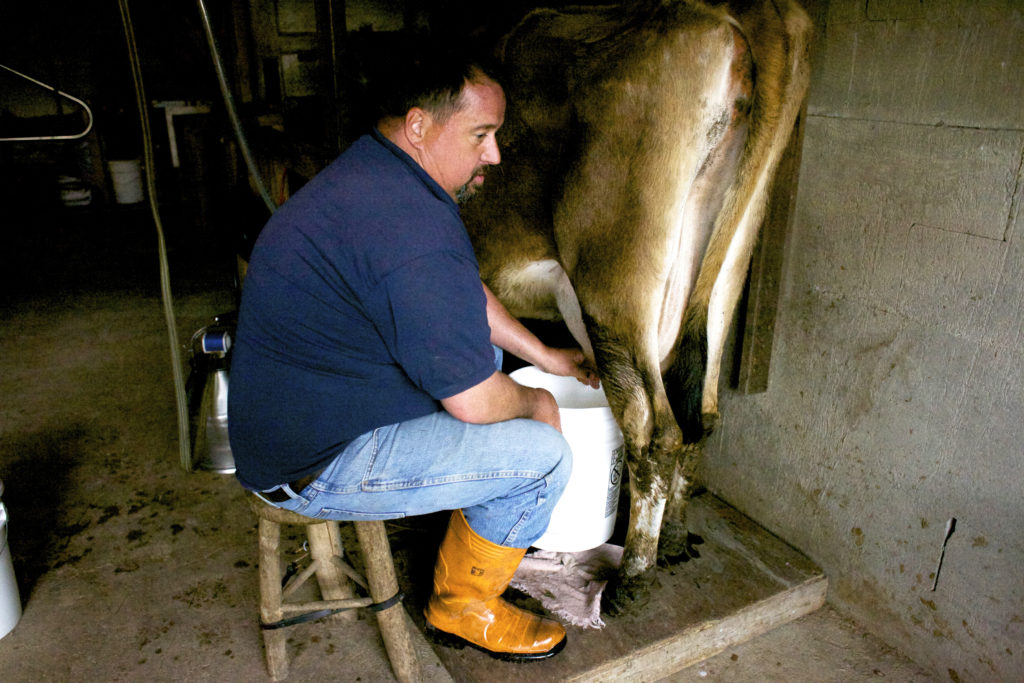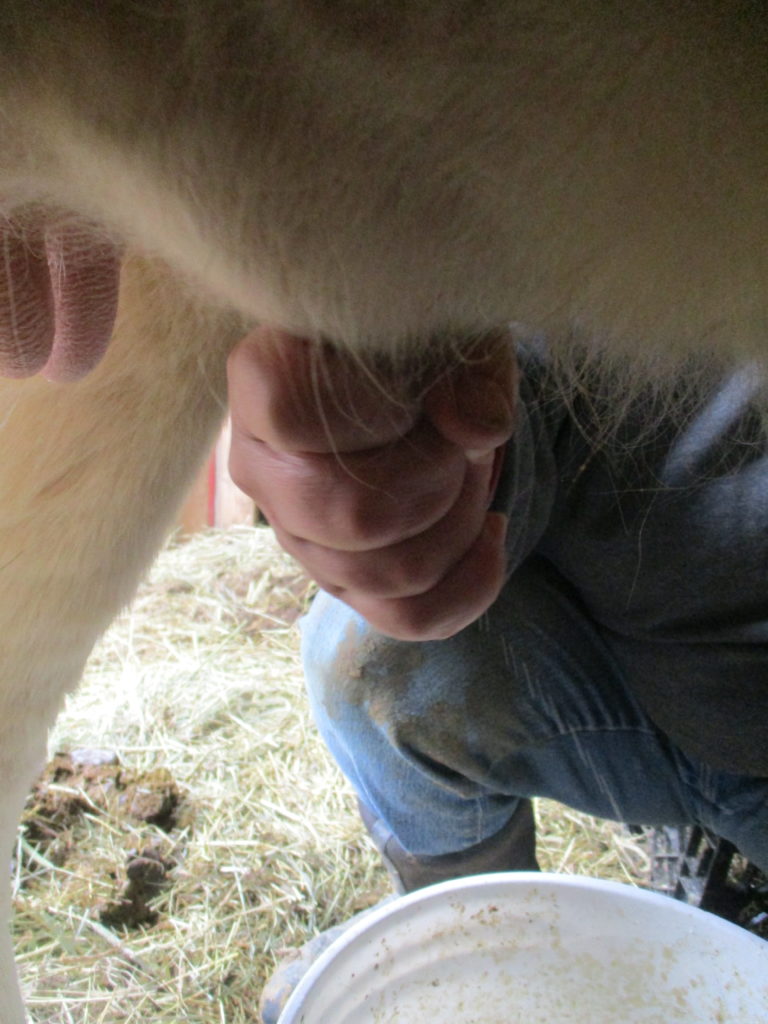How to milk a cow by hand

For thousands of years the only way for humans to get milk from a dairy cow was by hand, a labor-intensive process that can take up to 30 minutes per cow.
So it’s understandable that when the first automated milking machines appeared in the late 1800s, as soon as they could afford one, farmers and dairymen were automating their milking operations to speed up the process.
Milking machines have continued to evolve with innovations making them easier, cheaper, faster and more efficient for the farmer and more comfortable for the cow until now it’s difficult to find a dairy operation that has not automated.
Today’s machines can milk 100 cows in an hour, compared to the two or three cows a single worker can do by hand.
So, not a lot of people are milking cows by hand these days.
But there are those who still enjoy the up close and personal contact with their cows. At Farm in the Woods on Monson, Maine Gretchen Huettner and Doug Huettner milk their six cows — four Jerseys and two Ayshires — by hand every day.
“We are only milking once a day which is a new system for us,” Gretchen Huettner said. “Once a day milking is becoming more common on small operations where labor is an issue.”
Getting ready to milk
Every day before even heading out to the barn, Gretchen Huettner makes sure all of her needed equipment — like containers for the collected milk, sterile nitrile gloves for her hands and pre-udder treatment dips — are clean and ready.
“I have found that food grade plastic [pitchers] work well for hand milking because you can hold the pitcher with one hand and milk [the cow] with the other,” she said. “If a cow is kicky or antsy for some reason you can get the container out of the way to keep feet from contaminating the milk.”
While Gretchen Huettner is on her way to barn, her 15-year-old daughter and barn manager Susannah Huettner is already out there making sure the cows are clean and ready for milking.
“She brushes their flanks if they laid in something [dirty], she scoops up all the cow [manure] and puts down fresh bedding,” Gretchen Huettner said. “She will also make sure that they have all had some hay because they are much more content during milking if they have a full belly and are fat and happy.”
Any that do not appear 100 percent ready to be milked undergo additional examination by the Huettners and, if necessary, professional medical care is called in.
The most common ailment with dairy cows is mastitis — inflammation or infection that can occur in the breasts of nursing and lactating mammals. Symptoms include lumps, discoloration in the milk, watery milk or bloody milk.
Cleanliness is key
Cleanliness, she said, is key when it comes to milking cows and milk production.
The pitchers she uses to collect the milk are replaced on a regular basis every 12 to 18 months. According to Gretchen Huettner, by that time, even after the best and most consistent cleaning there is a risk of bacteria building up in them.
“We do not use bleach products,” Gretchen Huettner said. “Good old soap and super hot water works great.”
Hands on
Once a cow is cleared for milking, Gretchen Huettner first predips each teat — there are four per udder — with a 1/2-percent iodine dip. She then waits 60 seconds and dries the teats with brown dairy paper towels. These are single use, clean, super absorbent paper towels made specifically for the dairy industry. They enable the Huettners to gently dry off each cow teat without scratching the animal. At the same time, because they are single use, it greatly reduces the risk of transferring any microbes from one cow to another. Dairy towels are available from farm and livestock supply outlets.
She next checks the milk from each teat by quickly stripping — or removing a small amount of milk that remained in the udder from the previous day’s milking. This not only removes the leftover milk, it allows her to check more closely for signs of mastitis. “I will sometimes spray the milk on my black rubber boot or on the brown towel to check it,” she said.
Gretchen Huettner looks for any visible signs of mastitis that can show up in milk like a bloody or an overly watery appearance The boot or towel provides a handy background and surface for this inspection.
Assuming there are no health or other issues with the cow, it’s time to get to it.

According to Gretchen Huettner, it’s a matter of grabbing a single teat by your thumb and pointer finger at the top of the teat near the base of the udder and slowly working the milk down the teat’s canal.
“My favorite cows for hand milking are cows with longer, slightly chubbier teats,” she said. “Because you can grip them better and use all your fingers to slowly squeeze the milk.”
The key, she said, is starting at the top of the teat and slowly rolling or curling your fingers one-by-one down and around the teat.
“When I milk into a bucket [instead of a hand-held pitcher] I can milk with two hands and get a nice rhythm going,” Gretchen Huettner said. “Milking opposite teats works really well when milking with two hands.”
She then moves on to the next teat — or “udder quarter” — until all four are milked.
Just when you think you are done, Gretchen Huettner said, a cow can have a second “let down” when more milk enters the udder and you want to make sure you get that.
“That milk usually has the highest cream in it,” she said. “So I will milk all the quarters and then go back to see if there is anything else.”
Finishing up
Once all the milk is collected, each teat is again treated with the 1/2 percent iodine solution.
The faster the collected milk is cooled the better, Gretchen Huettner said.
“We take the milk inside [the house] and filter it right away using a special filter designed for milk,” she said. “Then the milk is refrigerated right away.”
If you are milking more than one or two cows, it can be helpful to have someone running the inside operations so the milk can be filtered and cooled quickly, she said.
If you are operating solo, Greatchen suggests covering the milk-filled pitchers or buckets and placing them in dishpans full of very cold water until the milk can be filtered.
“During extremely warm weather cooling needs to happen quickly because bacteria can grow quickly,” she said.
Once the cows are inspected, treated, milked and the milk cooled, filtered and refrigerated, the Huettners are done milking for the day.
“Then it is time to wash everything up and have it ready for the next milking.”
